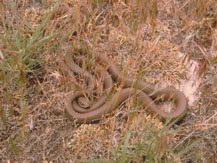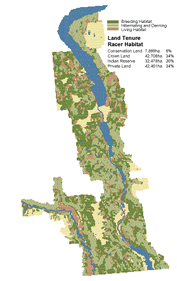|
Habitat Atlas for Wildlife at Risk
Racer
Coluber constrictor

Racer
|

- Other Name: Western Yellow-bellied Racer.
- Total length up to 120 cm.
- Juveniles have blotched pattern on back that slowly
disappears as they mature; pattern superficially
resembles that of a young rattlesnake.
- Slender, stream-lined snakes with a large, long,
flattened head and rounded snout.
- Back and sides are usually a slate-grey or olive
green color; belly is vivid to whitish yellow.
Status:
British Columbia Blue List
Special Significance
Human development has encroached on many portions of
the range of Racers and has undoubtedly caused population
declines. Suitable habitat is located primarily in
valley bottoms, areas that are also ideal for agricultural
and housing developments. Racers may play a significant
role in agricultural areas where insects and rodents
can cause crop damage. Developing management plans
to protect this harmless snake from further decline
requires further research on their ecology. Racers
are protected under the British Columbia Wildlife
Act. However, snakes in general are often considered
undesirable animals and are killed for no apparent
reason.
Distribution
- In British Columbia, restricted to the dry interior bounded by
the Okanagan, Similkameen, Fraser and Thompson valleys.
- Mainly found in grasslands and ponderosa pine forests.
Habitat
- Racers live in a variety of habitats, including sandy desert areas,
grasslands, farmland, marshes, woodlands or open,
sparsely-treed areas.
- Forage in sandy terraces along riparian margins, presumably
because of the food supply in riparian areas and
the sunny, warm conditions provided by the terraces.
- Hibernate on south-facing rocky slopes, often with
other species of snakes.
- Nests may occur in loose soil, beneath flat stones,
in decaying wood or on stable talus slopes.
Reproduction
- Emerge from communal hibernation sites in March or April and immediately
disperse to summer range.
- Females may be able to reproduce in consecutive years
only if they have sufficient fat reserves.
- Mate in May on the summer range.
- Eggs (average of 6) are laid in communal nests during
late June or early July; nests are often abandoned
rodent burrows with a southern exposure.
- Eggs hatch in late August or early September.
Food Habits
- Juveniles consume crickets and grasshoppers; adults eat insects,
young mammals, small reptiles, birds and frogs.
- Racers do not constrict prey, but pin prey down with
their bodies.
- Racers are generally active during daylight.
Interesting Facts
- Probably the most heat-tolerant species of snake in British Columbia.
- Racers are able climbers and may be found in bushes.
- Hibernating dens may be shared with rattlesnakes,
gopher snakes and garter snakes.
Encounters
- When cornered, snakes may attempt to bite in defense.
- Racers are not poisonous, and pose no threat to humans.
Threats
- Extensive land development in the Okanagan has
eliminated or fragmented their habitat
(including dens and feeding grounds).
- Dens are particularly susceptible to human development;
snakes may not relocate to other areas if
dens are destroyed, and availability of suitable hibernating
sites may be limited.
- Disruption of nesting sites could have serious
impacts on the population.
- Humans' general fear of snakes leads to snakes
being killed when encountered. They are also
inadvertently killed by farm and road vehicles.
- Use of pesticides may contaminate insect populations.
Management Considerations
- Reduce and monitor use of pesticides.
- Identify and protect dens and nesting sites.
- Leave 1 km buffer zone around known den sites
and critical habitats.
- Avoid road construction near talus slopes and
around known snake dispersal routes.
- Avoid disturbing rock and woody debris in potential
snake habitat.
- Maintain good range condition in grasslands
for cover and habitat for prey species.
|
References
1. Shewchuk, C.H. and H.L. Waye. 1995. Status of the Western Yellow-bellied
Racer in British Columbia. Ministry of Water, Land and Air Protection,
Lands and Parks. Victoria, British Columbia
2. Gregory, P.T. and R.W. Campbell. 1984. The reptiles
of British Columbia. British Columbia Provincial Museum Handbook No.
44. Victoria, BC.
3. Orchard, S.A. 1984. Amphibians and Reptiles of British
Columbia; an Ecological Review. Ministry of Forests. Victoria, British
Columbia
|